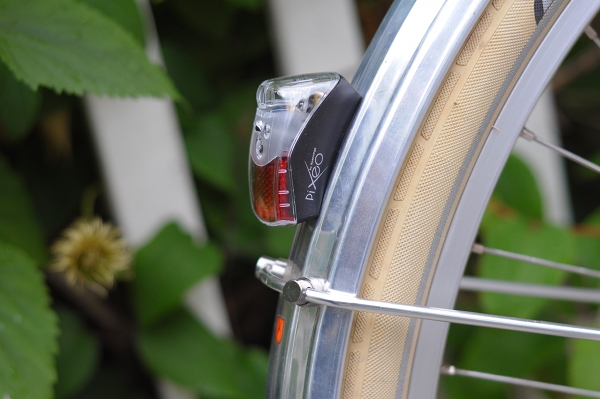 What do you think of using bicycle lighting with automatic sensory settings? Several of our bikes are equipped with lighting systems that allow for this, but I have mixed feelings about the auto-mode.
What do you think of using bicycle lighting with automatic sensory settings? Several of our bikes are equipped with lighting systems that allow for this, but I have mixed feelings about the auto-mode.Last week the Co-Habitant installed the Spanniga Pixeo tail light on his bike (very thorough review of this lighthere) and set it on auto. Cycling together later that evening, I switched my own lights on when dusk fell. As I rode behind him, his Pixeo tail light would switch on and off in response to slight changes in lighting conditions. For example, as we entered a stretch of road with fewer trees, it would switch off; then on again when the trees became more dense. Not only did I find this annoying while cycling behind someone, but I was also surprised that the light did not "think" it was dark enough to just stay on the entire time. It wasn't quite pitch black, but getting there. I wonder how the settings are configured, and whether they can be adjusted.
 I have an auto ("senso") feature on my Busch & Muellerdynamo lighting as well, that I sometimes use and sometimes do not. Because this system includes a headlight, I can tell whether the auto mode is performing the way I want it to. If it gets dark but my headlight does not automatically turn on (which means the tail light is not on either), I will just switch it to the permanent "on" position. With a battery-operated tail light like the Pixeo and others, there is no way to get this feedback. Since you can't see you own tail light while cycling, you have to be confident that its "idea" of when's dark enough is the same as yours. For me that is not always the case with the lighting I've tried, which is why I am not that crazy about auto settings. What has been your experience?
I have an auto ("senso") feature on my Busch & Muellerdynamo lighting as well, that I sometimes use and sometimes do not. Because this system includes a headlight, I can tell whether the auto mode is performing the way I want it to. If it gets dark but my headlight does not automatically turn on (which means the tail light is not on either), I will just switch it to the permanent "on" position. With a battery-operated tail light like the Pixeo and others, there is no way to get this feedback. Since you can't see you own tail light while cycling, you have to be confident that its "idea" of when's dark enough is the same as yours. For me that is not always the case with the lighting I've tried, which is why I am not that crazy about auto settings. What has been your experience?
No comments:
Post a Comment